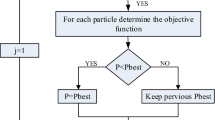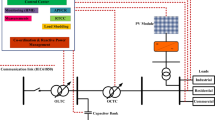Abstract
A power distribution system operates most efficiently with voltage deviations along a feeder kept to a minimum and must ensure all voltages remain within specified limits. Recently with the increased integration of photovoltaics, the variable power output has led to increased voltage fluctuations and violation of operating limits. This paper proposes an optimization model based on a recently developed heuristic search method, grey wolf optimization, to coordinate the various distribution controllers. Several different case studies on IEEE 33 and 69 bus test systems modified by including tap changing transformers, capacitors and photovoltaic solar panels are performed. Simulation results are compared to two other heuristic-based optimization methods: harmony search and differential evolution. The simulation results show the effectiveness of the method and indicate the usage of reactive power outputs of PVs facilitates better voltage magnitude profile.



















Similar content being viewed by others
References
U.N.E. Programme, Global trends in renewable energy investment 2016, frankfurt school-unep centre bnef. Tech. rep. (2016). Accessed 10 Apr 2016
Katiraei F, Aguero JR (2011) Solar PV integration challenges. IEEE Power Energy Mag 9(3):62
Gonen T (2014) Electric power distribution engineering. CRC Press, Boca Raton
GmbH JSE (2016) Voltage regulated distribution transformer. Tech. rep. Accessed 10 Apr 2016
Mouli GRC, Bauer P, Wijekoon T, Panosyan A, Barthlein EM (2015) Design of a power-electronic-assisted OLTC for grid voltage regulation. IEEE Trans Power Deliv 30(3):1086
Rule 21 smart inverter working group technical reference materials, california energy commission. http://www.energy.ca.gov/electricity_analysis/rule21/ (2016). Accessed 12 Dec 2016
Ceylan O, Liu G, Xu Y, Tomsovic K (2014) Distribution system voltage regulation by distributed energy resources. In: 2014 North American power symposium (NAPS), Pullman, WA, pp 1–5. doi:10.1109/NAPS.2014.6965466
Liu G, Ceylan O, Xu Y, Tomsovic K (2015) Optimal voltage regulation for unbalanced distribution networks considering distributed energy resources. In: 2015 IEEE power & energy society general meeting, Denver, CO, pp 1–5. doi:10.1109/PESGM.2015.7286473
Rao SS (2009) Engineering optimization: theory and practice, 4th edn. Wiley, New York
Holland HJ (1992) Genetic algorithms. Sci Am 267:66–72
Storn R, Price K (1997) Differential evolution—a simple and efficient heuristic for global optimization over continuous spaces. J Glob Optim 11(4):341. doi:10.1023/A:1008202821328
Zong WG, Joong HK, Loganathan GV (2001) Simulation 76(2):60. http://sim.sagepub.com/content/76/2/60.abstract
Kennedy J, Eberhart R (1995) Particle swarm optimization. In: Proceedings of the IEEE international conference on neural networks, 1995, Perth, WA, vol 4, pp 1942–1948. doi:10.1109/ICNN.1995.488968
Mirjalili S, Mirjalili SM, Lewis A (2014) Grey wolf optimizer. Adv Eng Softw 69:46–61
Emary E, Zawbaa HM, Hassanien AE (2016) Binary grey wolf optimization approaches for feature selection. Neurocomputing 172:371
Rios LM, Sahinidis NV (2012) Derivative-free optimization: a review of algorithms and comparison of software implementations. J Glob Optim 56(3):1247. doi:10.1007/s10898-012-9951-y
Zhu Y, Tomsovic K (2007) Optimal distribution power flow for systems with distributed energy resources. Int J Electr Power Energy Syst 29(3):260
Ochoa LF, Dent CJ, Harrison GP (2010) Distribution network capacity assessment: variable DG and active networks. IEEE Trans Power Syst 25(1):87
Borghetti A, Bosetti M, Grillo S, Massucco S, Nucci CA, Paolone M, Silvestro F (2010) Short-term scheduling and control of active distribution systems with high penetration of renewable resources. IEEE Syst J 4(3):313
Calderaro V, Conio G, Galdi V, Massa G, Piccolo A (2014) Optimal decentralized voltage control for distribution systems with inverter-based distributed generators. IEEE Trans Power Syst 29(1):230
Agalgaonkar YP, Pal BC, Jabr RA (2014) Distribution voltage control considering the impact of PV generation on tap changers and autonomous regulators. IEEE Trans Power Syst 29(1):182
Kwang MAES, Lee Y (2008) Modern heuristic optimization techniques: theory and applications to power systems. Wiley, New York
Mohanty S, Subudhi B, Ray PK (2016) A new MPPT design using grey wolf optimization technique for photovoltaic system under partial shading conditions. IEEE Trans Sustain Energy 7(1):181
Sharma S, Bhattacharjee S, Bhattacharya A, Generation IET (2016) Grey wolf optimisation for optimal sizing of battery energy storage device to minimise operation cost of microgrid. Transm Distrib 10(3):625
Jayakumar N, Subramanian S, Ganesan S, Elanchezhian EB (2016) Grey wolf optimization for combined heat and power dispatch with cogeneration systems. Int J Electr Power Energy Syst 74:252
Sulaiman MH, Mustaffa Z, Mohamed MR, Aliman O (2015) Using the gray wolf optimizer for solving optimal reactive power dispatch problem Appl. Soft Comput 32:286
National grid load profiles. https://www9.nationalgridus.com/niagaramohawk/business/rates/5_load_profile.asp (2016). Accessed 03 Apr 2016
Nrel, measurement and data center. http://www.nrel.gov/midc/ (2016). Accessed 10 June 2016
Baran ME, Wu FF (1989) Network reconfiguration in distribution systems for loss reduction and load balancing. IEEE Trans Power Deliv 4(2):1401. doi:10.1109/61.25627
Baran ME, Wu FF (1989) Optimal capacitor placement on radial distribution systems. IEEE Trans Power Deliv 4(1):725. doi:10.1109/61.19265
Kersting WH (2012) Distribution system modeling and analysis. CRC Press, Boca Raton
Andreas A, Wilcox S (2016) Solar technology acceleration center (solartac), aurora, colorado (data). Tech. Rep. DA-5500-56491, NREL. doi:10.5439/1052224
Lowry range solar station, colorado state land board. doi:10.5439/1052550 (2014). Accessed 11 June 2016
Xcel energy comanche station. http://www.nrel.gov/midc/xecs (2011). Accessed 11 June 2016
Sun spot one san luis valley, colorado. http://www.nrel.gov/midc/ss1 (2010). Accessed 11 June 2016
Andreas A, Wilcox S (2016) Solar resource and meteorological assesment project (solrmap), rotating shadowband radiometer (rsr), los angeles, california (data). Tech. Rep. DA-5500-56502, NREL. doi:10.5439/1052230
Solar resource and meteorological assesment project, tri-state, ecalante. doi:10.5439/1052229 (2013). Accessed 11 June 2016
Wolpert DH, Macready WG (1995) No free lunch theorems for search. Technical Report SFI-TR-95-02-010, Santa Fe Institute, 1995. https://pdfs.semanticscholar.org/bfd2/88d7adb887ea0c91d14131f4cb78d675f0a4.pdf
Acknowledgements
This work was sponsored by the Office of Electricity Delivery & Energy Reliability, US Department of Energy under Contract No. DE-AC05-00OR 22725 with UT-Battelle and conducted at ORNL and UT Knoxville. This work also made use of Engineering Research Center Shared Facilities supported by the Engineering Research Center Program of the National Science Foundation and the Department of Energy under NSF Award Number EEC-1041877 and the CURENT Industry Partnership Program. The first author would like to thank the Scientific and Technological Research Council of Turkey (TUBITAK) for its financial support.
Author information
Authors and Affiliations
Corresponding author
Additional information
Notice of Copyright: This manuscript has been authored by UT-Battelle, LLC under Contract No. DE-AC05-00OR22725 with the U.S. Department of Energy. The United States Government retains and the publisher, by accepting the article for publication, acknowledges that the United States Government retains a non-exclusive, paid-up, irrevocable, worldwide license to publish or reproduce the published form of this manuscript, or allow others to do so, for United States Government purposes. The Department of Energy will provide public access to these results of federally sponsored research in accordance with the DOE Public Access Plan (http://energy.gov/downloads/doe-public-access-plan).
Rights and permissions
About this article
Cite this article
Ceylan, O., Liu, G. & Tomsovic, K. Coordinated distribution network control of tap changer transformers, capacitors and PV inverters. Electr Eng 100, 1133–1146 (2018). https://doi.org/10.1007/s00202-017-0563-x
Received:
Accepted:
Published:
Issue Date:
DOI: https://doi.org/10.1007/s00202-017-0563-x




